Image: Woman in kente. Photo by X-Lens Media
Africa is a vast continent with thousands of tribes. Each of these tribes has its unique way of doing things. One of such is the way they dress. Africans are known for their colorful and vibrant attires, which are often displayed during cultural events.
If you have ever been to one of such African traditional events, you would have noticed the unique attires which are markers of the continent’s rich cultural legacy.
Years back, these attires were worn only during festivities and other special occasions, but due to European influence, things are fast changing. Some African attires that used to be seen as special are fast becoming everyday wear as some creative designers have found ways to combine them with other kinds of fabrics to give them a more modern and less serious look.
From the Ghanaian Kente to the Isidwaba worn by South African women, each African country has its unique ways of dressing that will always make its people stand out. You have not been richly dressed until you have worn one of these African traditional attires.
Aso-Oke
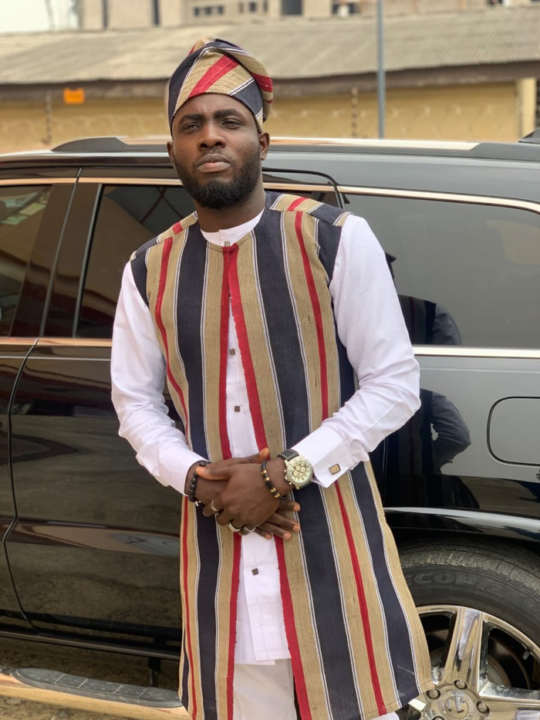
Image: Man wearing aso oke. Source: Wikimedia Commons
This is one of the most prestigious hand-woven cloths created by the Yoruba people of West Africa. More than just a fabric, it is one of the ways tangible aspects of Yoruba clothing tradition can be experienced. Traditionally, it was woven from three materials – cotton, red imported silk called alari, and a domestic wild raw silk called sanyan. Today these materials are often replaced by rayon and metallic lurex.
The women wear it as a blouse (buba), a wrapped skirt (iro), a head tie (gele), and a shoulder sash called an “iborun” or “ipele”. It is worn by the men in the form of agbadas (a three-piece outfit consisting of pants (shokoto), an embroidered pull-over shirt (dashiki), and a large pull-over robe (agbada).
The aso-oke has successfully held its own as the special occasion fabric of the Yoruba people. It is worn during major ceremonies such as weddings, funerals, naming ceremonies, and important religious festivals.
Kente
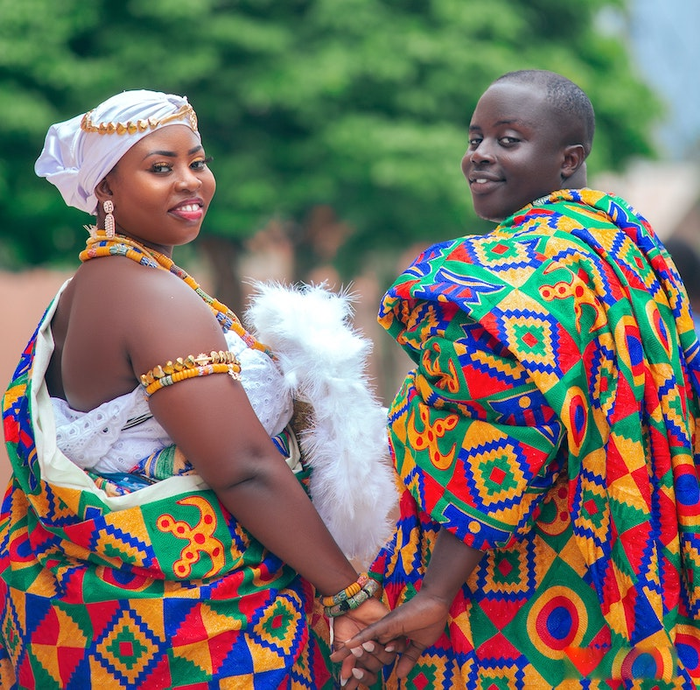
Image: Couple wearing kente. Source: Wikimedia Commons
One of the most dramatic and colorful fabrics, Kente is native to the people of Ghana. It is traditionally made from silk and cotton threads woven in a narrow strip called ntomaban or bankuo. There are two main strands of Kente in Ghana representing two ethnic groups – the Ashanti and the Ewe. Each design has a significant meaning that reflects the cultural values of Ghanaians as well as historical events. The colors also have symbolic meanings.
Kente was originally made and worn only by royals and is often used for special occasions and ceremonies. Though it is widely available to all today, it has retained its elegance. It has been adopted by the modern world and its popularity has soared with the printed kente designs version, which are affordable. However, the handwoven one is still very expensive. But, can we really call it Kente if it is printed and not handwoven?
Kanzu
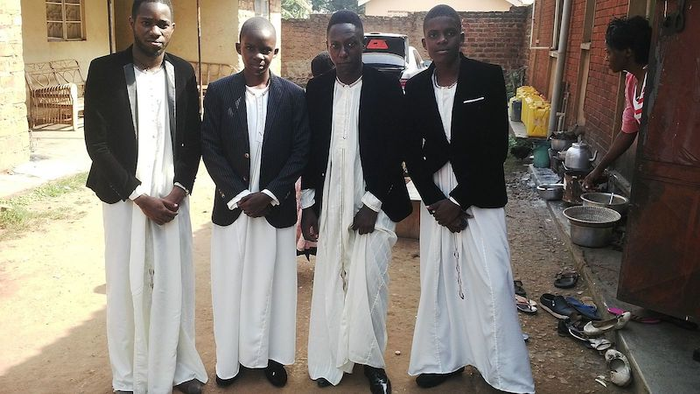
Image: Men wearing kanzu for a wedding. Source: Wikimedia Commons
The Ugandan kanzu was introduced to the Buganda Kingdom by Arab traders. This white or cream African traditional clothing worn by men in the African Great Lakes region was high society fashion, reserved for the classiest of the brood. It was made out of cotton and linen materials that were as coveted as they were expensive. Years have passed and the Kanzu remains an iconic symbol of culture and ceremony and is worn to weddings and festivals. “Men of culture” wear the Kanzu to give them an aura of authority and sophistication.
Kaftan
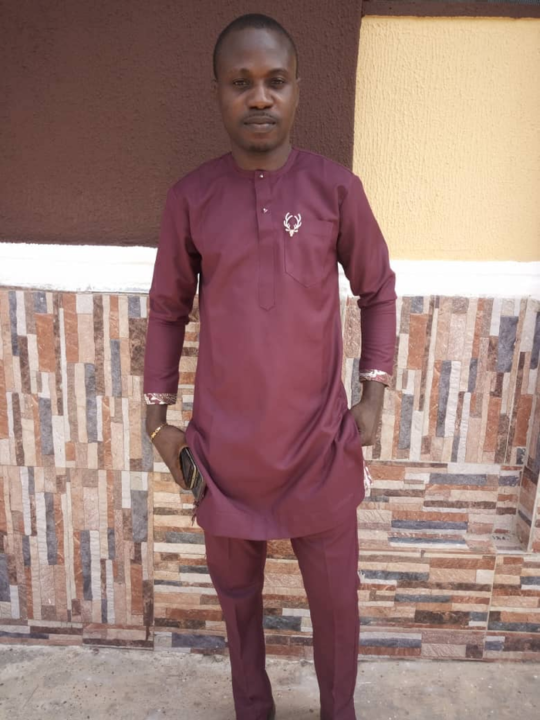
Image: Nigerian man in kaftan. Source: Wikimedia Commons
This long, flowing robe is worn by both men and women across North and West Africa. Often worn as a coat or an overdress, usually having long sleeves and reaching to the ankles, Kaftan is usually made of cotton brocade, silk, lace, or synthetic fabrics. It is popular in countries like Morocco, Senegal, and Nigeria and the style can vary by region. In Algeria, the male kaftan is known as the kaftan of honor while the female kaftan is engraved in the intangible cultural heritage of humanity.
Djellaba
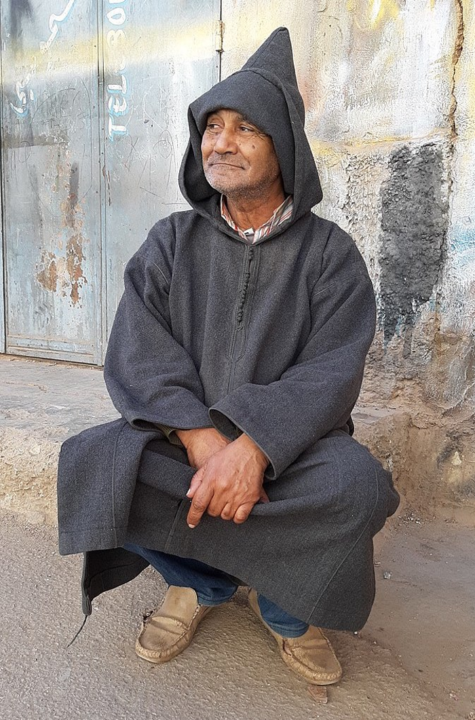
Image: Man in djellaba. Source: Wikimedia Commons
The djellaba or jillaba also written gallabea is a long, hooded robe worn by both men and women in North Africa, particularly Morocco. It originated in the Amazigh (Berber) cultures of North Africa and is different from other popular Moroccan clothes such as kaftans and gandoras. Its versatility makes it one of the most essential items in the Moroccan wardrobe, reflecting both locally available materials and the regional climate. It is designed for comfort and protection from the sun. Traditionally, the main material for designing djellabas is wool. However, these days lightweight cotton djellabas have become trendy.
Kanga
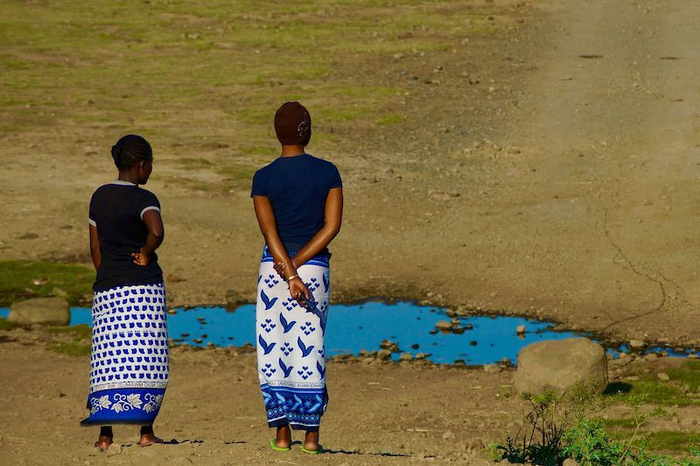
Image: Women wearing kangas. Source: Wikimedia Commons
Also called Leso in Kenya, Kanga is an African print fabric that originated in East Africa and is worn by women and occasionally by men, majorly in Swahili-speaking countries. Just like other West African famous prints – Kangas are colorful, thin, and lightweight. It is made of cotton, rayon, polyester, or a mixture of fabrics, and is often given as a gift for birthdays or other special occasions. It includes three sections: “pindo”, representing the border; “mji”, the middle, with different decorations, and “jina”, an inscription written on the fabric, usually in that language or Lingala, in the case of Central Africa.
Isidwaba

Image: Women wearing isidwaba. Source: Facebook | Uthingo Traditional Attires
This traditional, leather skirt, is worn by married, Zulu women. It is made from genuine leather which could either be cowhide or goatskin. It is usually given as a gift by the father of the bride which she wears on her wedding day. It also plays a critical role that affords her ancestral protection from her new-found ancestors. This African traditional attire has maintained its form and design among South African women.
Maasai Shuka
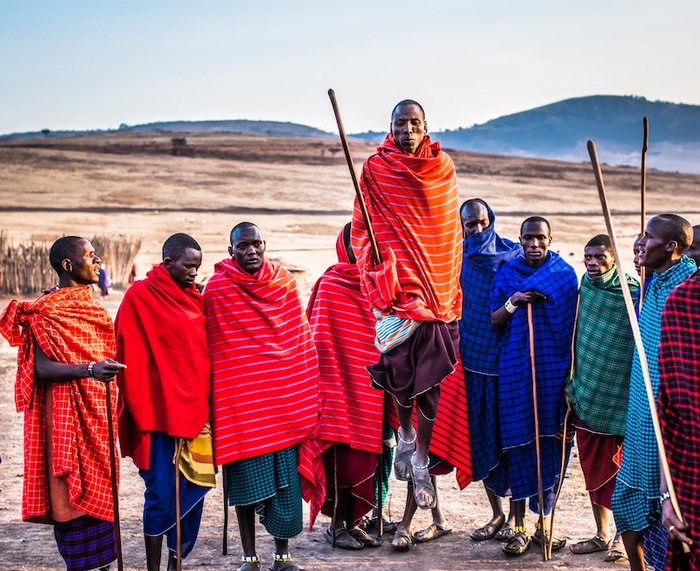
Image: Maasai men. Photo by Follow Alice on Pexels
Popularly called the ‘African Blanket’, the Maasai Shuka is a traditional cloth worn by the Maasai people in East Africa, primarily Kenya, and Tanzania. Often red with black stripes, shuka is a versatile fabric used as clothing, blankets, and for various practical purposes. Before the Scottish colonized Tanzania and Kenya, the Shuka was the customary attire for high-ranking members of the society. In recent years, this traditional garment has been transformed into fashionable urban wear, and gaining fame all over the globe.
Isiagu
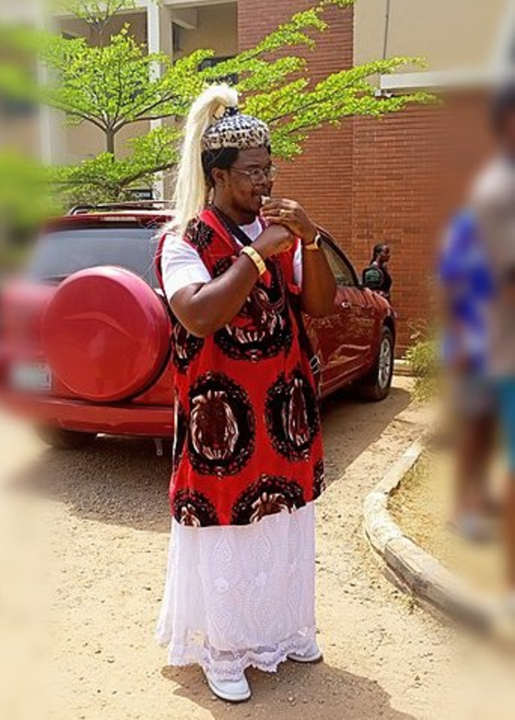
Image: Man wearing isiagu. Source: Wikimedia Commons
This traditional attire is well-known in Igbo culture. It features intricate lion’s head patterns and is usually worn during special events, such as weddings and chieftaincy titles, among others. The Isiagu fabric comes in cotton or velvet with the head of a lion emblazoned in a definite pattern. It comes in diverse colors of choice. The loose-fitting top has long or short sleeves and is usually worn over a pair of black trousers or knitted wrappers tied around the waist.
In times past, only men wore this attire, but things have changed as women now use this beautiful fabric to make lovely styles, even wedding dresses.
Boubou
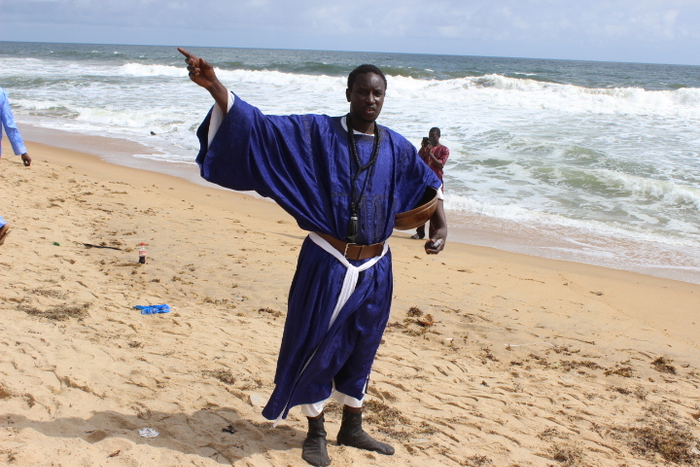
Image: Senegalese man in boubou. Source: Wikimedia Commons
As the suit is to Europe, so is the boubou to Africa. The Boubou is a wide, classic, stylish, and flowing gown commonly worn in West Africa, particularly Senegal and Mali. It is often made from colorful and lightweight fabric and can be styled in various ways.
Boubous are a wardrobe staple for West African communities and beyond. Worn by both men and women all over Africa, it is made of one large rectangle of fabric with an opening in the center of the neck. When worn it drapes down over the shoulders and billows at the sleeves.
Dashiki
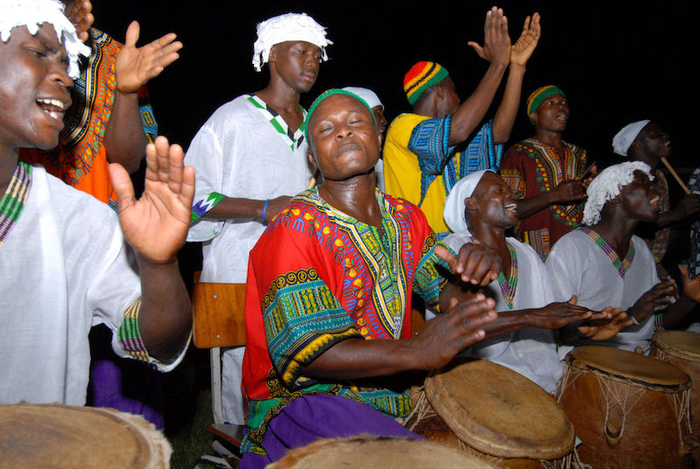
Image: Ghanaian drummers wearing dashiki shirts. Source: Wikimedia Commons
This traditional attire originated from West Africa, particularly Nigeria. Some others say it is indigenous to the Ewe people of Ghana. Dashiki is a colorful and loose-fitting shirt with ornate embroidery patterns, often made from cotton fabric. Dashikis are stylish, and colorful, and have become a symbol of African cultural identity. In the last several years, Dashiki shirts have been increasingly popular as streetwear items.
Toghu/Atoghu
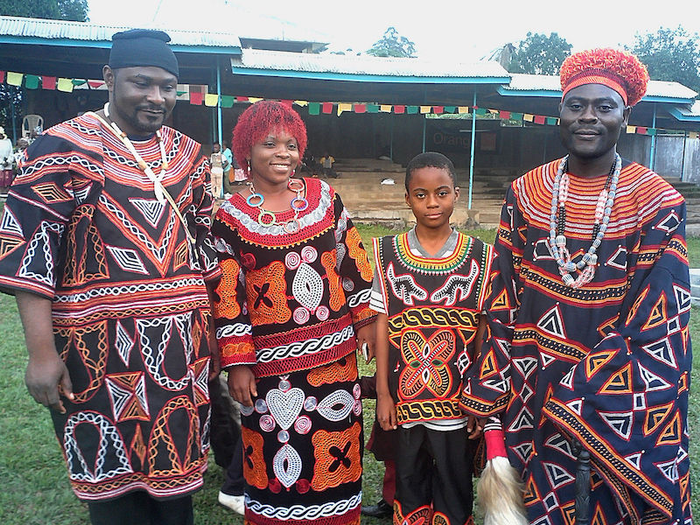
Image: Family wearing toghu. Source: Wikimedia Commons
Atoghu also known as Toghu is a traditional outfit from the North West region of Cameroon. It used to be worn by royalty and dignitaries as a sign of traditional superiority over the commoner. It is made of black velvety fabric and is well-known for its unique, colorful handmade embroidery and hard-wearing. Its rich multicolored hand embroidery usually around the neck, sleeve, and finish of the costume makes it stand out amongst other cultural attires from Cameroon and Africa.
This African attire which was previously most seen or worn in traditional celebrations has been reinvented in recent years and has gone global.





